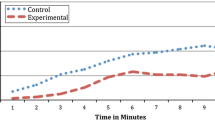Abstract
This paper presents an apparatus that intentionally makes a person sensitive to mental tension by controlling his/her breathing pattern. The apparatus is called abdominal breathing restrictor (ABR). ABR realizes mental control function based on the knowledge of the relationship between breathing patterns and mental condition. Abdominal breathing is well known to relax the mental state of a person. Conversely, costal breathing results in mental tension. The ABR impedes abdominal breathing and compels one into costal breathing, leading him/her into mental tension. The experimental results described in this paper demonstrate that ABR successfully controlled the mental state of a subject. ABRs can be used to control mental condition of the audience in movie theaters.











Similar content being viewed by others
References
James W (1950) The principles of psychology, vol 2. Dover Publications, New York
Tsujita H, Rekimoto J (2011) Happiness Counter: Smile-encouraging appliance to increase positive mood. In: Proceedings of CHI 2011. Vancouver, BC, Canada, May 7–12, 2011, pp 117–126
Bacon M, Poppen R (1985) A behavioral analysis of diaphragmatic breathing and its effects on peripheral temperature. J Behav Ther Exp Psychiatr 16(1):15–21
Boyer BA, Poppen R (1995) Effects of abdominal and thoracic breathing upon multiple-site electromyography and peripheral skin temperature. Percept Mot Skills 81(1):3–14
Ring C, Carroll D, Willemsen G et al (1999) Secretory immunoglobulin A and cardiovascular activity during mental arithmetic and paced breathing. Psychophysiology 36:602–609
Guyenet PG (2006) The sympathetic control of blood pressure. Nat Rev Neurosci 7(5):335–346
Baharav A, Kotagal S, Gibbons V et al (1995) Fluctuations in autonomic nervous activity during sleep displayed by power spectrum analysis of heart rate variability. Neurology 45:1183–1187
Taelman J, Vandeput S, Spaepen A et al (2008) Influence of mental stress on heart rate and heart rate variability. IFMBE Proc 22:1366–1369
Yamamoto Y, Hughson RL, Peterson JC (1991) Autonomic control of heart rate during exercise studied by heart rate variability spectral analysis. J Appl Physiol 71(3):1136–1142
Akselrod S, Gordon D, Ubel FA et al (1981) Power spectrum analysis of heart rate fluctuation: a quantitative probe of beat-to-beat cardiovascular control. Science 213(4504):220–222
Author information
Authors and Affiliations
Corresponding author
About this article
Cite this article
Nakayama, I., Koga, K. & Kobayashi, J. Abdominal breathing restrictor for mental tension enhancement. Artif Life Robotics 20, 124–128 (2015). https://doi.org/10.1007/s10015-015-0205-1
Received:
Accepted:
Published:
Issue Date:
DOI: https://doi.org/10.1007/s10015-015-0205-1




